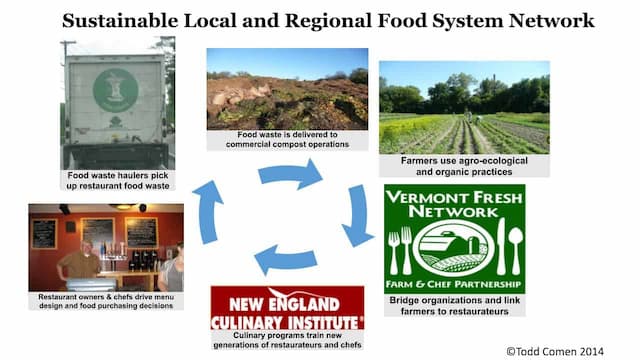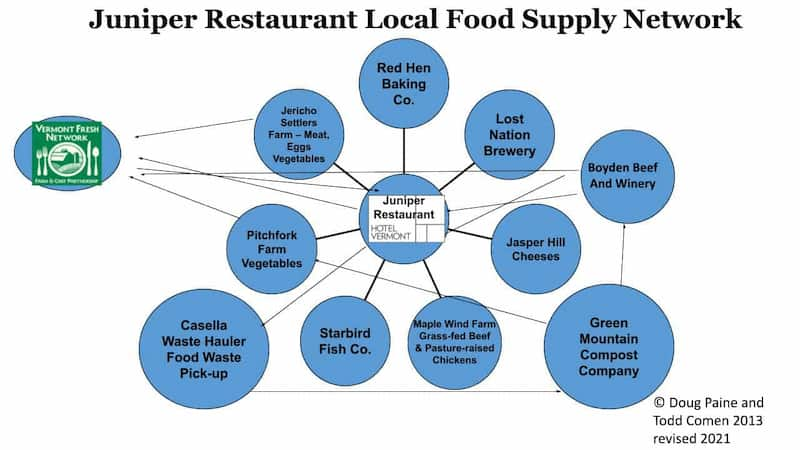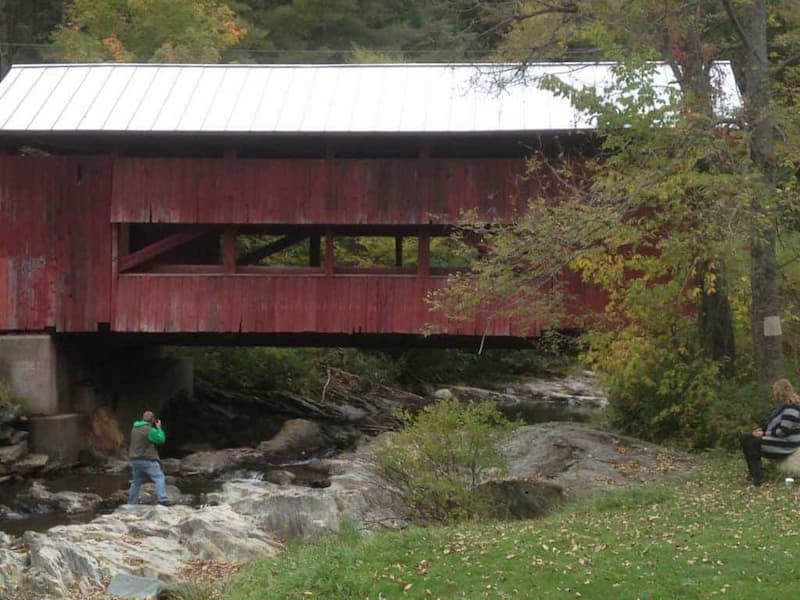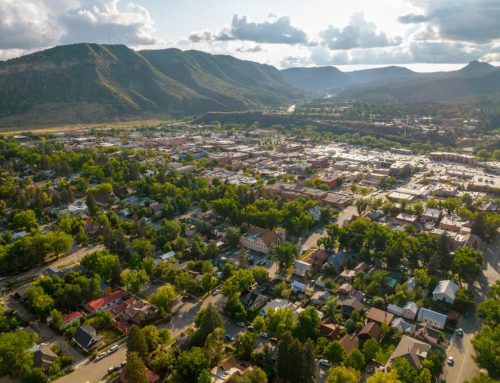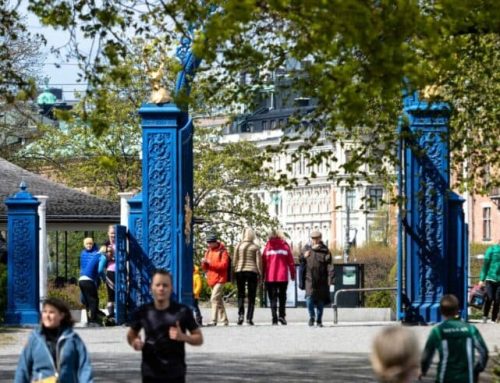Destination Stewardship Report – Summer 2021 (Volume 2, Issue 1)
This post is from the Destination Stewardship Report (Summer 2021, Volume 2, Issue 1), an e-quarterly publication that provides practical information and insights useful to anyone whose work or interests involve improving destination stewardship in a post-pandemic world.
A key part of good destination stewardship is to favor tour operations that support the people who live there. But does that really work in practice? And actually make money? Agritourism specialist Todd Comen decided to give it a try in his home state of Vermont.
Localizing a Vermont Tour
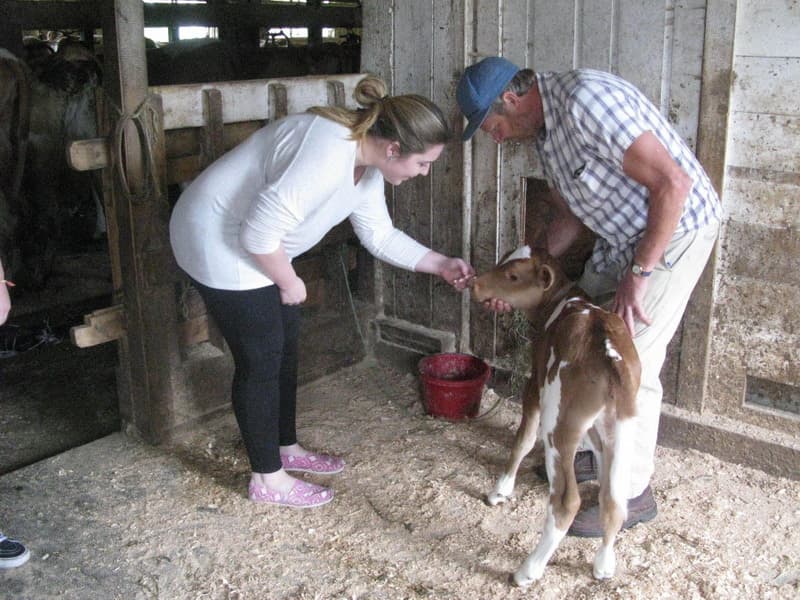
Visitors have a personal encounter with a young calf, as they visit a local farm and learn about the importance of rural and agricultural communities in a strong regional food supply network [Photo by Todd Comen]
Hypothesis: Integrated Rural Tourism Actually Works
In 2015, I wanted to test a theory of rural tourism: my own. In the year 2000 I had introduced a theory of Integrated Rural Tourism at the 1st World Congress on Rural Tourism held in Perugia, Italy, organized by Prof. Adriano Ciani of University of Perugia. The theory went something like this: In rural communities, entrepreneurs can supplement their income stream by delivering services to visitors based on their personal strengths and core assets. Once a number of entrepreneurs successfully do this, the rural communities in which they live and work should begin to experience some level of economic revitalization. Direct visitor services in rural communities might include guided tours, food or beverage, lodging, retail, and cultural or adventure activities.
To test my theory I created and operated for three years a part-time Vermont tour company named Bonafide Tours and Expeditions. Would operating a small rural tour business be an effective way to diversify my income and, perhaps more to the point of the theory, would the tour operations encourage economic development in struggling rural communities? The goal of the trial was to provide opportunities for visitors staying in regional centers such as Burlington or Stowe to venture to off-the-beaten-path places in the surrounding rural areas. Theoretically, the result would be financial support and recognition for rural entrepreneurs, especially small farmers in those areas.
The bundled components of an Integrated Rural Tourism experience should give visitors a sense of the unique flavor of a region – natural attractions, unique value-added agricultural enterprises, tangible and intangible cultural heritage, and the people who bring life to the visitor experience.
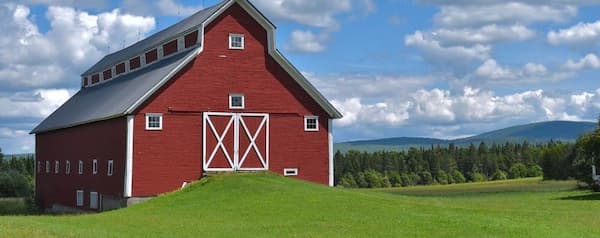
Vermont’s rural landscape is home to many small farm operations that form the basis of the local food supply network – and tourist appeal [Photo: “Summer at the Vermont Barn” by ‘fossiled’]

Four tour guests pose by Lake Elmore [Photo by Todd Comen]
The tours were typically six-to-eight-hour drives that included lunch and snacks at a historic general store or a locally owned café. Farm and specialty food entrepreneurs shared personal stories and gave personalized tours to the visitors. The visitors frequently purchased specialty gifts and food and beverage products from the businesses.
Guests paid between $150 – $250 per person for a guided, day-long tour. Meals, snacks, and wine and beer tastings were included in the total price. All-inclusive pricing ensured that visitors ate heartily and that the businesses would receive fair compensation from hosting the visitors. Donations were encouraged at historic sites where no attendant was present. Wealth from tourism was thus spread across the rural community.
Food, Glorious Food!
As you can see, a typical tourism experience involves food. For many popular destinations, however, most of the food consumed by visitors is part of a long-distance supply chain stretching from where ingredients are grown and processed to where the meals are served. Initiatives to build sustainable linkages between local farmers and tourism businesses have faltered in many parts of the world, but in Vermont linkages have strengthened over the past twenty years due to support from a variety of key stakeholder groups including state government, farmers market organizations, consumers, and interested restaurant owners and chefs. One goal of Bonafide Tours and indeed an Integrated Rural Tourism strategy is to encourage and support a robust local and regional food system supply network to benefit farmers and other community members, thus building local linkages and ultimately contributing to the resiliency of destination.
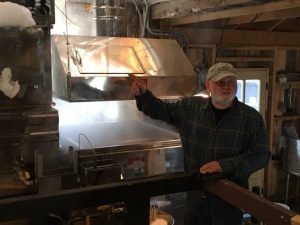
A maple syrup producer explains the process of sugaring [Photo by Todd Comen]
Stopping points during the Bonafide tour experience reinforced the story of regional food. Such tour operators can work with local restaurants to find out where they source their raw ingredients. The stop at Morse Farm, for instance, enabled tour guests to learn the story behind the syrup that they may have had for breakfast at their hotel. Visiting farms, food processors, and craft beverage makers that sell to restaurants where tourists have eaten demonstrate the dynamic relationships of a resilient local food system.
Urban-Rural Linkages Through Food and Agriculture
The model (shown below) of a local and regional food supply network represents key components of an interconnected, circular economy built on mutually beneficial partnerships. Tour guests are introduced to the complex food system networks evolving in the state of Vermont. They meet the chefs who prepare specialty food products for them and learn of the culinary training programs that teach chefs how to source and prepare ingredients grown and processed locally.
To enrich the Bonafide guest experience, tours connected visitors to the farmers and specialty food producers that supplied restaurants where visitors were inclined to dine while in the region. For example, tourists lodging at Hotel Vermont would often dine at either Juniper or Hen of the Woods, two farm-to-table restaurants in the hotel. Both restaurants have actively participated in reimagining the local and regional food system that they are a part of, including how ingredients are sourced, how food is grown, and how food is processed, delivered, stored, and even prepared.
From Dirt to Dirt
Guests also discover business innovations, including food waste hauling enterprises, bridge organizations such as the Vermont Fresh Network and other food hub or distribution enterprises, and composting operations at various scales. Managing food waste from restaurant operations has also been a focus of these and all other restaurants in Vermont since diverting food waste from landfills is required by law in Vermont as of spring 2020. This new approach to food waste management requires disposal, waste hauling, and processing of food waste into soil amendments that go back to farmers, completing the circular economy from farm to table and back again.
This diagram of a local and regional food supply network of the Juniper Restaurant in Hotel Vermont, a frequent pick-up point for my tours, illustrates the relationships the chef and hotel management team built over time with local and regional specialty food and beverage suppliers. This robust supply network features farmers, fishers, and myriad other small businesses contributing to the unique, authentic menu of the restaurant. Symbiotic relationships such as these build a healthy and resilient food system.
In situations where farm-to-table partnerships are limited or non-existent, a good substitute is visiting farmers markets or specialty food stores that carry locally grown produce or locally raised meats or dairy products. Sometimes, stopping by the edge of a farm field may have to suffice to explain how the farm and its crops fit into the economic and cultural milieu of the community. In time, the tour operator will realize that relationships with the farmers will inspire them to share their story of the farm and farm life, which in turn opens the door to expanding partnerships with the consumer and possibly restaurateurs.
Tour Operation: Lessons Learned
Business partnerships – Hotels and resorts are the conduit for customers for small tour companies. Visitors staying in primary anchor destinations are eager to explore backroads and agritourism enterprises with the assistance of an experienced guide.
Marketing partnerships – Hotel and resort employees become spokespersons for the tour operation. Familiarization trips, newsletters, and personal relationships add up to referrals, which are the lifeblood of the small tour business.
Market segments – People who enjoy exploring a rural destination include young professionals, food and beverage enthusiasts, retired explorers, seasoned photographers, landscape appreciators, and friends and families.
Community benefit – Tour design can spread the wealth from visitors. By integrating a variety of distinctive small businesses and special places you can achieve cohesive and personalized visitor experiences for specific market segments. Small farm operations with retail sections, historic cultural sites, local eateries, general stores, and craft food and beverage enterprises make up the tour experience.
Key takeaways from my three years of participant observation operating Bonafide Tours include:
- Low start-up costs if done right; primarily variable costs rather than fixed costs.
- Marketing is about building relationships with people who will promote the experience.
- Partnerships need to be mutually beneficial and cooperative.
- Pricing communicates value of the tour, so don’t underprice a high quality experience.
- All-inclusive pricing ensured that tourist wealth was shared among rural enterprises.
- Monitor guest satisfaction during the tour, and adapt the tour as needed with input from guests.
- Even in a drive market such as Vermont, people appreciate guided driving tours that get off the beaten path accompanied by experts with local knowledge.
- High ratings on a third party review site such as Trip Advisor will help sell tour experiences!
Testing my theory of Integrated Rural Tourism demonstrated that over time, even a small tour operator can make a profit while boosting revenue streams in rural communities. Stopping at farms, maple sugar houses, general stores and cafes, and even the historic sites enabled visitors to spend money on gifts. Since the price of the tour included lunch, snacks, beverage tastings, and entrance fees, businesses visited by the tour always received revenue, achieving the goal of the theory of Integrated Rural Tourism. The test was a success!
The lesson for destinations seeking sustainable economic benefits? Encourage would-be entrepreneurs to diversify their income by launching small tourism enterprises like the one described in this article. Requirements include time, energy, customer service skills, partnerships, persistence, and a little creativity. That’s it, combined with a steady stream of visitors eager to get off the beaten path and out into rural communities.
Featured Partnerships of Bonafide Tours and Expeditions
- Hotel Vermont
- Lodge at Spruce Peak
- Trapp Family Lodge and Brewery
- Boyden Winery
- Morse Farm Sugar Works
- Shelburne Vineyards
- Falls General Store
- Stowe Hard Cider
- Red Hen Baking Company
- Elmore General Store
- Lost Nation Brewing
- Rankin Family Farm
- Majestic Car Rental
About the Author
Todd Comen ([email protected]) is an agritourism expert and professor of hospitality and tourism who works with rural entrepreneurs worldwide. Vermont Strategy Group


